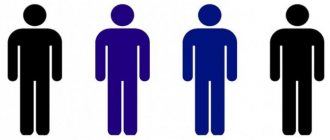Social status (from the Latin status - position, condition) is the position of an individual in society, determined by his age, gender, profession, education, ethnic and religious affiliation, marital status and other characteristics. A person’s personal status characterizes his position in the small (or primary) ) social group, which is determined by its individual qualities. Social status implies a set of rights and responsibilities that connect a person with other members of society and social groups. In society there is a hierarchy of statuses - personal and group. The place in the hierarchy of statuses is called status rank. Depending on the position in this hierarchy (which is determined by the level of prestige, authority, qualifications), the following types of status ranks are distinguished: high, medium, low. Social statuses provide stable social connections between subjects of social action, determine the nature of interpersonal and group relations, form interests and people’s value systems and regulate their activities in accordance with these settings. The system of social statuses is relatively stable: society ensures its reproduction by distributing individuals into certain social positions (through receiving education, advanced training, creating a family, etc.). Edit
Status set
Each person is a member of several social groups, collectives, and public organizations at once, so he occupies several positions in the social structure at the same time. The totality of all statuses of an individual is called a status set. The status set usually includes the following characteristics: - gender; - nationality; - age; - social origin; - education; - profession and level of qualifications; - financial situation; - rights and obligations; - marital status; - personal qualities; - interests. and hobbies.Edit
Social status. Types of statuses. Status set.
⇐ PreviousPage 2 of 3Next ⇒Social status is the social position occupied by a social individual or social group in society or a separate social subsystem of society. It is determined by characteristics specific to a particular society, which can be economic, national, age and other characteristics.
A status set is a set of status positions that each individual occupies simultaneously. In this set, the following statuses are usually distinguished: ascriptive (assigned), achieved, mixed, main.
Social status can be: prescribed
- received from birth or due to factors independent of its bearer - gender or age, race, socio-economic status of parents.
For example, by law you cannot obtain a driver's license, get married, vote in elections or receive a pension before reaching the required age; achieved
- acquired in society thanks to the efforts and merits of the individual.
A person’s status in society is affected by the level of education, professional achievements, career, and a socially successful marriage. No society can ignore the real successes of an individual, therefore the existence of an achieved status carries the opportunity to significantly compensate for the low ascribed status of the individual; personal -
manifests itself at the level of a small group in which the individual functions directly (family, work team, circle of close friends), it is determined by his personal qualities and character traits;
group -
characterizes an individual as a member of a large social group - a representative of a class, nation, profession, a bearer of certain gender and age characteristics, etc.
Basic status is the key of the entire set of social statuses of an individual, primarily determining his social position and significance in society.
Social role. Role set. Role conflict.
Social role
- this is a model of human behavior, objectively determined by the social position of the individual in the system of social, public and personal relations. In other words, a social role is “the behavior that is expected of a person occupying a certain status.”
A role set is a set of roles corresponding to a certain social status. Regulatory requirements associated with a social role, as a rule, are more or less known to the participants in role interaction and give rise to corresponding role expectations: all participants in the interaction expect from each other behavior that fits into the context of these social roles. However, the social role is considered not only in terms of role expectations (expectations), but also role performance, i.e. how the individual actually performs his role. Role conflict is a clash of role demands placed on an individual, caused by the multiplicity of social roles simultaneously performed by him. Role conflict in modern sociology is considered as a clash of role demands placed on an individual, caused by the multiplicity of social roles simultaneously performed by him. Sociologists distinguish two types of role conflicts: conflicts between social roles; conflicts within one social role. Inter-role conflicts arise when different social roles, the bearer of which is an individual, contain incompatible prescriptions (requirements). For example, a woman plays her role well at work, but at home she fails in the roles of wife and mother. In a situation where the husband's parents do not like his wife, his filial duty conflicts with the husband's duties. Intra-role conflicts arise where a social role involves complex relationships and conflicting social expectations. Within many social roles there are conflicts of “interest,” for example, the requirement to be honest with people conflicts with the desire to “make money.”
The concept of social mobility. Types of social mobility. Mechanisms (channels) of social mobility.
Social mobility is a change by an individual or group in their social position in social space. The concept was introduced into scientific circulation by P. Sorokin in 1927. He identified two main types of mobility: horizontal and vertical. Vertical mobility involves a set of social movements, which is accompanied by an increase or decrease in the social status of an individual. Depending on the direction of movement, a distinction is made between upward vertical mobility (social rise) and downward mobility (social decline). Horizontal mobility is the transition of an individual from one social position to another, located at the same level. An example is movement from one citizenship to another, from one profession to another that has a similar status in society. By type of mobility , sociologists distinguish between intergenerational and intragenerational. Intergenerational mobility presupposes the nature of changes in social status between generations and allows us to determine how much children rise or, conversely, fall on the social ladder compared to their parents. Intragenerational mobility is associated with social career, meaning a change in status within one generation. Channels of social mobility can be : school, education in general, family, professional organizations, army, political parties and organizations, church.
These social institutions serve as mechanisms for the selection and selection of individuals, placing them in the desired social stratum.
Of course, in modern society education is of particular importance, the institutions of which serve as a kind of “social elevator” that ensures vertical mobility. Moreover, in the conditions of transition from an industrial society to a post-industrial (information) society, where scientific knowledge and information become the decisive factor in economic and social development, the role of education increases significantly. At the same time, it should be noted that the processes of social mobility may be accompanied by marginalization and lumpenization of society. Marginality as an intermediate, “borderline” state of a social subject. Marginal - when moving from one social group to another, he retains the same system of values, connections, habits and cannot learn new ones (migrants, unemployed). In general, marginalized people seem to lose their social identity and therefore experience great psychological stress. Lumpen - trying to move from an old group to a new one in the process of social mobility, finds himself completely outside the group, breaks social ties and over time loses basic human qualities - the ability to work and the need for it (beggars, homeless people, declassed elements).
⇐ Previous2Next ⇒
System of Protected Areas in the USA The study of specially protected natural areas (SPNA) in the USA is of particular interest for many reasons...
Live by the rule: IS THERE NOT MUCH THING IN THE WORLD EXISTING? It is no coincidence that I emphasize that the space in your head is limited, but there is a lot of information around, and that your right...
WHAT IS CONFIDENT BEHAVIOR IN INTERPERSONAL RELATIONSHIPS? Historically, there are three main patterns of differences that exist between...
Conflicts in family life. How can I change this? It is rare that a marriage and relationship exists without conflict and tension. Everyone goes through this...
Didn't find what you were looking for? Use Google search on the site:
Prestige and authority
Social status is associated with the concepts of “prestige” and “authority”. Prestige is an assessment by society or a social group of certain positions occupied by an individual in the social structure, based on a certain value system; a measure of recognition of an individual’s merits. The prestige of a social status is determined both by the real contribution of the individual occupying this status to the satisfaction of social needs, and by socio-psychological factors that influence the objectivity of the assessment. Authority is the degree of recognition by society of a person’s personal and business qualities. Authority implies the non-violent influence of an individual on the minds of people, public opinion: a person occupying an authoritative position in any social group enjoys the respect, trust, and attention of other group members who recognize and highly value his knowledge, skills, achievements, and talents.Edit
Types of social statuses
In social science, different types and types of social statuses are distinguished. Innate (innate, inherited) status is given to an individual biologically, at birth, regardless of his abilities, personal qualities and efforts. Examples of innate statuses: nationality, gender, race. Acquired (achieved) status is associated with the individual activity of a person to acquire a certain position in society, achieved as a result of personal choice and conscious efforts. Examples of acquired statuses: professor, doctor of science, president of the country, general. Prescribed status is a social position that is prescribed to an individual from the moment of birth (or assigned to him after years by society) regardless of his personal merits. Examples of prescribed statuses: Muscovite, nobleman. The article is in the categories InterpretationStatus set A complex of group permanent (assigned and acquired) social statuses that characterize the subject’s position in society and a certain set of social roles. Terms and concepts of linguistics: General linguistics. Sociolinguistics: Dictionary-reference book. — Nazran: Pilgrim LLC. T.V. Foaling. 2011.
See what “Status set” is in other dictionaries:
- Status set - A complex of group permanent (assigned and acquired) social statuses, characterizing the position of a subject in society and defining a set of social roles. Among the S.N. basic status is the position of the subject in society as a whole. See also: ... ... Dictionary of sociolinguistic terms
- status set - A complex of group permanent (attributed and acquired) social statuses that characterize the position of a subject in society and a certain set of social roles... Dictionary of linguistic terms T.V. Foal
- Status set - all the statuses that an individual has at a given time ... Dictionary-reference book for social work
- A status set is the entire set of statuses that characterize a given person in the variety of his interactions with other individuals from the point of view of fulfilling his rights and obligations... Sociological Dictionary Socium
- Social position - Social status is the position occupied by an individual or social group in society or a separate subsystem of society. It is determined by characteristics specific to a particular society, which can be economic,... ... Wikipedia
- Social status - Social status is the position occupied by an individual or social group in society or a separate subsystem of society. It is determined by characteristics specific to a particular society, which can be economic,... ... Wikipedia
- Position in society - Social status is the position occupied by an individual or social group in society or a separate subsystem of society. It is determined by characteristics specific to a particular society, which can be economic,... ... Wikipedia
- Social status - The position of an individual in society, his permanent or temporary place in social hierarchies of various types, which determines relationships with other members of society. The term can be used in different meanings. 1. Undifferentiated... ... Dictionary of sociolinguistic terms
- Mafia (game) - This term has other meanings, see Mafia (meanings). This article is about a 1986 parlor role-playing game. An article about a computer video game from 2002 is here M A F I YA Developer(s) Dmitry Davydov ... Wikipedia
- VALUE - one of the main. elements of culture, along with custom, norm, value and meaning; a specifically cultural means of connecting a person with the outside world or, in general, a subject with an object through signs. If in economic activities... ... Encyclopedia of Cultural Studies
The word consists of 9 letters: the first is s, the second is t, the third is a, the fourth is t, the fifth is y, the sixth is s, the seventh is n, the eighth is s, the last is th,
The word status in English letters (transliterated) - statsnyi
- The letter c
appears 2 times. Words with 2 letters s - The letter t
appears 2 times. Words with 2 letters t - The letter a
appears 1 time. Words starting with a - The letter y
appears 1 time. Words starting with y - The letter n
appears 1 time. Words starting with n - The letter s
appears 1 time. Words starting with y - The letter y
appears 1 time. Words starting with y
Social studies abstract. Topic 14. Social status of the individual.
Social studies abstract. Topic 14. Social status of the individual.
Social status
- this is the position of a person in society, occupied by him in accordance with age, gender, origin, profession, marital status.
My summary: define the concept of social status
Concept Generic characteristic Species characteristic
Social status
This is a specific position in the social structure of a group or society, connected to other positions through a system of rights and responsibilities.
One person has many statuses because he participates in many groups and organizations. He is a man, a father, a husband, a son, a teacher, a professor, a doctor, a middle-aged man, a member of the editorial board, an Orthodox Christian, etc. One person can occupy two opposite statuses, but in relation to different people: for his children he is a father , and for his mother a son.
The set of all statuses occupied by one person is called a status set
(this concept was introduced into science by the American sociologist Robert Merton).
My summary: define the concept of status set
Concept Generic characteristic Species characteristic
Status set
In a status set there is sure to be a main status.
The main status is the most characteristic status for a given person, with which he is identified (identified) by other people or with which he identifies himself. The main status is relative - it is not uniquely associated with gender, race or profession. The main thing is always the status that determines the style and lifestyle, the circle of acquaintances, and the manner of behavior.
My summary: define the concept of main status
Concept Generic characteristic Species characteristic
Main status
Although statuses
do not directly enter into social relations, but only indirectly - through their carriers, they mainly
determine the content and nature of social relations.
A person looks at the world and treats other people in accordance with his status (the poor despise the rich, and the rich treat the poor with disdain, a professional investigator divides people into potential criminals, law-abiding and witnesses, a Russian is more likely to show solidarity with a Russian than with a Jew, and vice versa).
Political, religious, demographic, consanguineous, economic, professional statuses of a person determine the intensity, duration, direction and content of people’s social relations.
My summary:
how do statuses determine the content and nature of social relationships?
1.
2.
Social statuses can be prescribed or acquired.
The first category includes nationality, place of birth, social origin, etc., the second - profession, education, etc. Some statuses are prestigious, others - on the contrary.
My summary: types of statuses
Prestige
is society’s assessment of the social significance of a particular status. This hierarchy is formed under the influence of two factors:
- the real usefulness of the social functions that a person performs;
- value systems characteristic of a given society.
My summary: define the concept of prestige
Concept Generic characteristic Species characteristic
Prestige
The concept of social role.
The social status of an individual, first of all, influences his behavior.
The social role of an individual is a set of social functions acquired and performed by a person and their corresponding patterns of behavior.
Social role is a model of behavior focused on a given status. It can be defined differently - as a patterned type of behavior aimed at fulfilling the rights and responsibilities prescribed by a specific status.
My summary: define the concept of social role
Concept Generic characteristic Species characteristic
Social role
Each person has not one, but a whole set of social roles that he plays in society. Their combination is called the role system.
My summary: define the concept of role system
Concept Generic characteristic Species characteristic
Role system
Each individual has the opportunity to choose from a variety of social statuses and roles those that allow him to better realize his plans and use his abilities as effectively as possible.
Personal status
call the position of an individual in a social group, depending on how he is assessed and perceived by members of this group (friends, relatives) in accordance with his personal qualities. To be a leader or an outsider, the soul of the party or an expert means to occupy a certain place in the system of interpersonal relationships.
My summary: define the concept of personal status
Concept Generic characteristic Species characteristic
Personal status
Leader
Outsider
Social norms—prescribed rules of behavior—characterize a role, not a status. A role is also called the dynamic side of status. The words “dynamic”, “behaviour”, “norm” indicate that we are not dealing with social relationships, but with social interaction.
My summary: define the concept of social norms
Concept Generic characteristic Species characteristic
Social norms
Thus, we must learn:
- Social roles and social norms relate to social interaction;
- Social statuses, rights and responsibilities, the functional relationship of statuses relate to social relations;
- Social interaction describes the dynamics of society, social relations - its statics.
- Only behavior that meets the expectations of those functionally associated with a given status is called a role. Any other behavior is not a role.
My summary:
- Social roles and social norms relate to social A;
- Social statuses, rights and responsibilities, the functional relationship of statuses relate to social B;
- Social interaction describes the B of society, social relations - its G.
- Only such behavior that meets the expectations of those who are functionally associated with this status is called D. Other behavior is not a role.
Fill in the missing words:
- interaction,
- dynamics,
- relationship,
- role.
- statics,
A social role is impossible without such conditions as:
- expectations of group members functionally associated with this status;
- social norms that fix the range of requirements for fulfilling this role.
We can say that status emphasizes the similarities of people, and role emphasizes their differences. Thus, the role is individual behavior in accordance with one’s status. A person has the same status in each specific situation, but he can behave differently.
My summary: the relationship between status and role.
1.
2.
Each person has not one, but a whole set of social roles that he plays in society. Their combination is called the role system. The variety of social roles can cause internal conflict of the individual (if some of the social roles contradict each other).
My summary: define the concept of role system
Concept Generic characteristic Species characteristic
Role system
However, despite the fact that the behavior of an individual is largely determined by the status that it occupies and the roles that it plays in society, it (the individual) nevertheless retains its autonomy and a certain freedom of choice. And although in modern society there is a tendency towards unification and standardization of personality, its complete leveling, fortunately, does not occur. An individual has the opportunity to choose from a variety of social statuses and roles those that allow him to better realize his plans and make the most effective use of his abilities. Any role prescription outlines only a general pattern of human behavior, preserving for him the opportunity to choose the ways of its implementation.
My summary: the individual retains his autonomy thanks to
1.status,
2. roles,
3.freedom of choice









